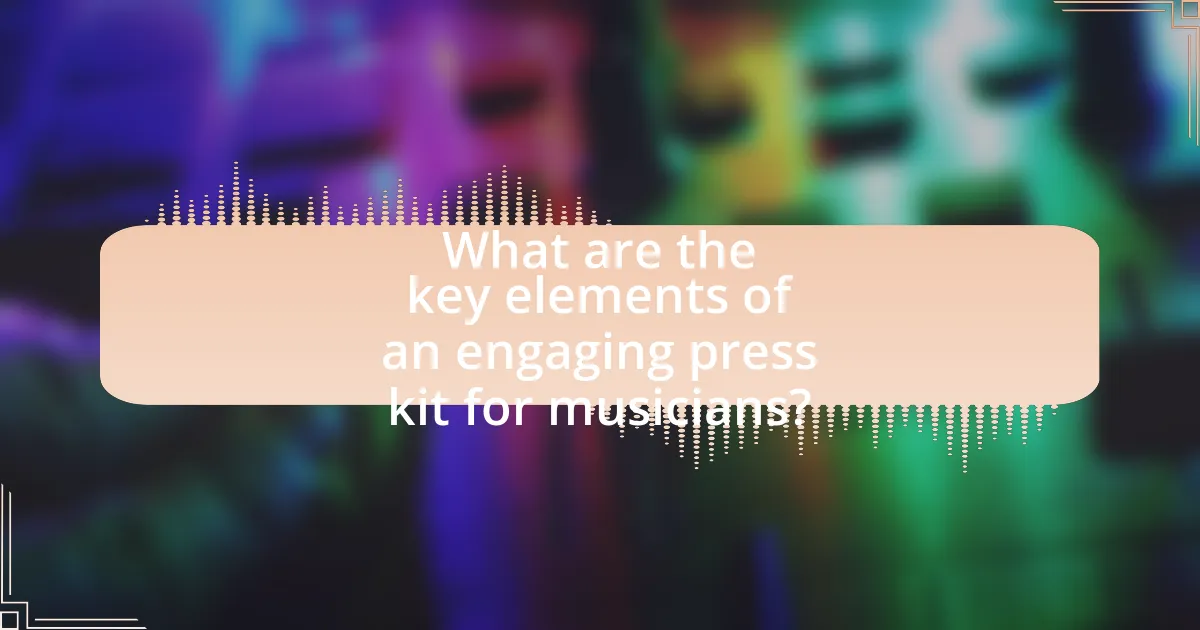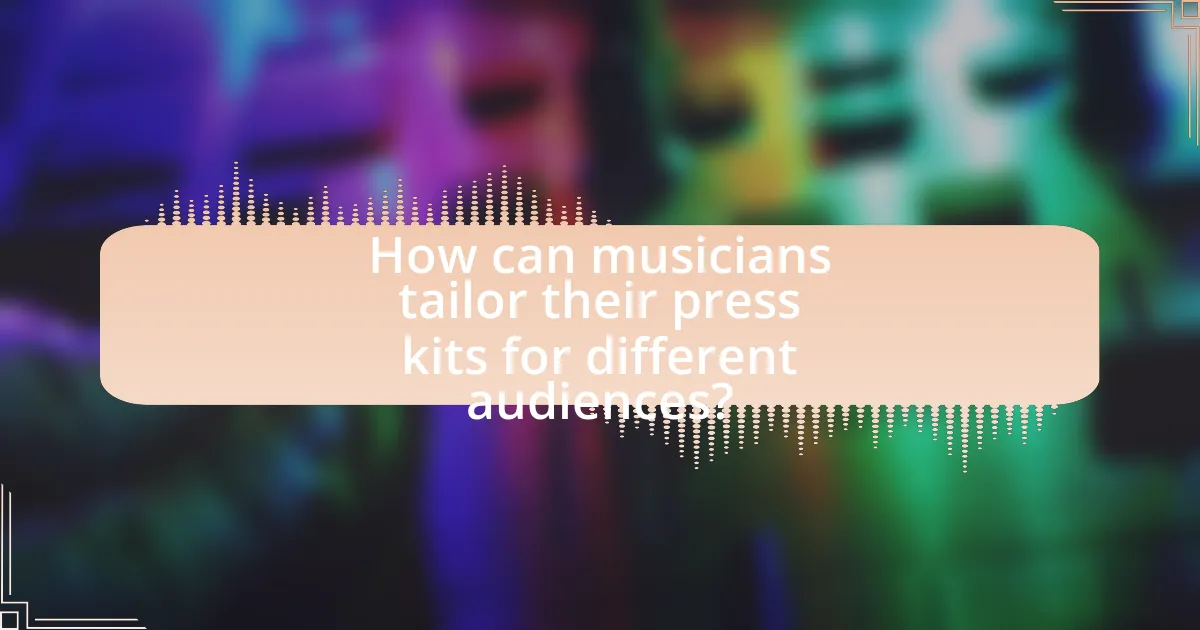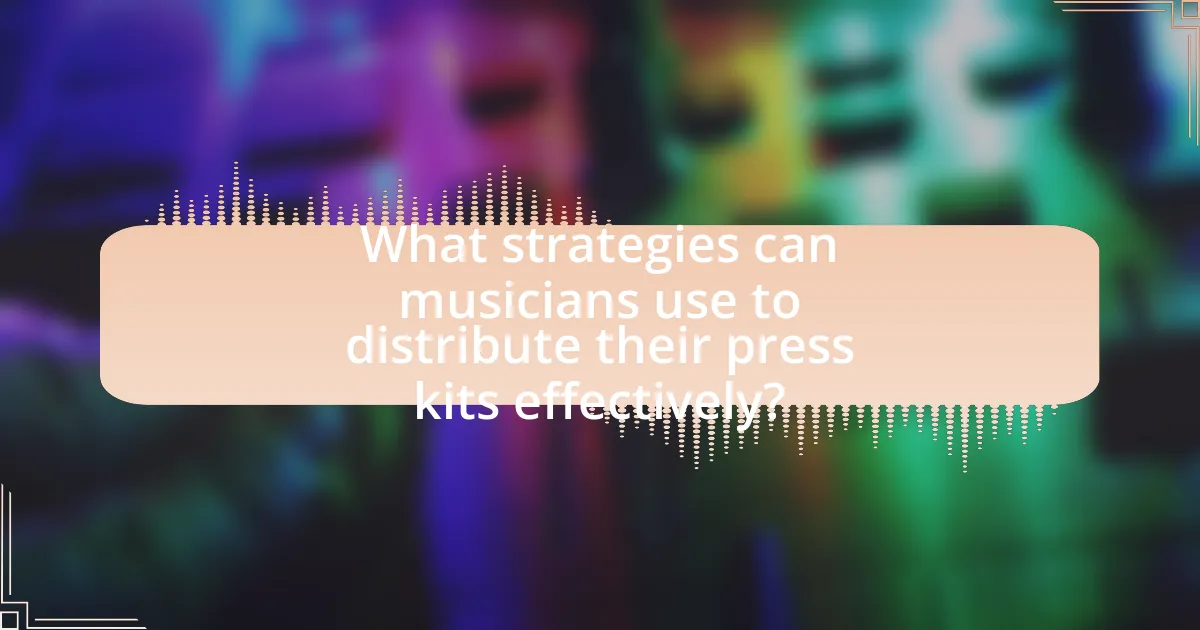The article focuses on strategies for creating engaging press kits for musicians, emphasizing the essential components such as professional biographies, high-quality images, music samples, press coverage, and contact information. It differentiates press kits from other promotional materials by highlighting their targeted approach for media professionals. The article also discusses the importance of visual branding, storytelling, and multimedia elements in enhancing a musician’s narrative and engagement. Additionally, it provides best practices for tailoring press kits to different audiences and genres, optimizing distribution methods, and avoiding common pitfalls in design and content.

What are the key elements of an engaging press kit for musicians?
An engaging press kit for musicians includes a professional biography, high-quality images, music samples, press coverage, and contact information. The biography should succinctly convey the artist’s background, achievements, and musical style, while high-quality images enhance visual appeal and brand identity. Music samples, ideally in various formats, allow media and promoters to experience the artist’s sound directly. Press coverage, such as reviews or features, adds credibility and showcases the artist’s reception in the industry. Finally, clear contact information ensures that interested parties can easily reach the artist or their management for bookings or inquiries. These elements collectively create a comprehensive and appealing press kit that effectively represents the musician.
How does a press kit differ from other promotional materials?
A press kit differs from other promotional materials by being a comprehensive package specifically designed to provide journalists and media outlets with essential information about an artist or event. Unlike general promotional materials, which may focus on advertising or marketing messages, a press kit typically includes a biography, high-resolution images, press releases, and relevant background information, all curated to facilitate media coverage. This targeted approach ensures that the information is not only informative but also tailored to meet the needs of media professionals, thereby increasing the likelihood of coverage.
What specific components should be included in a musician’s press kit?
A musician’s press kit should include a biography, high-resolution photos, music samples, press coverage, and contact information. The biography provides background and context about the musician, while high-resolution photos are essential for media use. Music samples allow potential promoters and venues to assess the artist’s style and quality. Press coverage showcases previous media attention, enhancing credibility. Lastly, contact information ensures that interested parties can easily reach the musician or their management for bookings or inquiries. These components collectively create a comprehensive representation of the musician, facilitating effective promotion and engagement.
Why is visual branding important in a press kit?
Visual branding is important in a press kit because it establishes a cohesive identity that enhances recognition and memorability. A well-designed visual brand, including logos, color schemes, and imagery, creates a professional appearance that can attract media attention and convey the musician’s unique style. Research indicates that consistent visual branding can increase brand recognition by up to 80%, making it a crucial element for musicians aiming to stand out in a competitive industry.
What role does storytelling play in a musician’s press kit?
Storytelling plays a crucial role in a musician’s press kit by creating a compelling narrative that connects the artist with their audience and media. This narrative helps to humanize the musician, making them relatable and memorable, which is essential for garnering interest from journalists and fans alike. For instance, a well-crafted story can highlight the musician’s journey, influences, and unique experiences, thereby providing context to their music. Research indicates that narratives can significantly enhance emotional engagement, which is vital in the music industry where personal connection often drives listener loyalty and media coverage.
How can musicians effectively convey their story in a press kit?
Musicians can effectively convey their story in a press kit by crafting a compelling narrative that highlights their unique journey, influences, and artistic vision. This narrative should include personal anecdotes, significant milestones, and the emotional motivations behind their music, which helps to create a connection with the audience and media. For instance, including details about how personal experiences shaped their songwriting can make the story relatable and engaging. Additionally, incorporating high-quality visuals, such as professional photos and album artwork, alongside quotes or testimonials from industry professionals can further enhance the narrative and provide context. This approach not only informs but also captivates the reader, making the musician’s story memorable and impactful.
What techniques can enhance the narrative aspect of a press kit?
Techniques that can enhance the narrative aspect of a press kit include storytelling, visual elements, and personal anecdotes. Storytelling engages the audience by presenting the musician’s journey, challenges, and achievements in a compelling way, making the narrative relatable and memorable. Incorporating visual elements, such as high-quality images and videos, can complement the written narrative and create a more immersive experience. Personal anecdotes add authenticity and emotional depth, allowing readers to connect with the musician on a personal level. These techniques collectively create a cohesive and engaging narrative that captures the essence of the musician’s brand and artistry.

How can musicians tailor their press kits for different audiences?
Musicians can tailor their press kits for different audiences by customizing content, visuals, and messaging to align with the interests and preferences of each specific group. For example, when targeting music industry professionals, musicians should emphasize their achievements, such as chart rankings or notable collaborations, while including high-quality audio samples and professional photos. Conversely, when addressing fans, the focus should shift to personal stories, upcoming events, and engaging visuals that resonate emotionally. Research indicates that targeted communication increases engagement rates by up to 50%, demonstrating the effectiveness of audience-specific press kits.
What factors should musicians consider when targeting specific media outlets?
Musicians should consider the audience demographics, media outlet reach, and content alignment when targeting specific media outlets. Audience demographics help musicians identify whether the outlet’s followers match their target listeners, ensuring effective communication. Media outlet reach indicates the potential exposure a musician can gain, with larger platforms offering broader visibility. Content alignment ensures that the musician’s style and message resonate with the outlet’s themes, increasing the likelihood of coverage. For instance, a rock band may target music blogs that focus on rock genres, while a classical musician might approach outlets that specialize in classical music.
How can musicians adapt their press kits for online versus print media?
Musicians can adapt their press kits for online versus print media by tailoring the content and format to suit each medium’s strengths. For online press kits, musicians should focus on interactive elements such as hyperlinks, embedded audio or video clips, and visually appealing graphics that enhance engagement. In contrast, print press kits should prioritize concise text, high-quality images, and essential information presented in a clear layout, as physical space is limited and immediate access to multimedia is not possible. This differentiation is supported by the fact that online content can leverage multimedia to capture attention, while print materials must convey information effectively in a static format.
What are the best practices for customizing press kits for different genres?
The best practices for customizing press kits for different genres include tailoring content, visuals, and messaging to align with the specific characteristics and audience expectations of each genre. For instance, a rock genre press kit should emphasize high-energy visuals and bold language, while a classical genre kit may focus on elegance and detailed biographies. Additionally, including genre-specific achievements, such as awards or notable performances, enhances credibility and relevance. Research indicates that targeted communication increases engagement; for example, a study by the Journal of Marketing found that personalized marketing efforts can boost response rates by up to 50%. Therefore, understanding genre nuances and audience preferences is crucial for effective press kit customization.
Why is it important to include multimedia elements in a press kit?
Including multimedia elements in a press kit is crucial because they enhance engagement and provide a richer storytelling experience. Visuals such as images, videos, and audio clips capture attention more effectively than text alone, making it easier for journalists and media outlets to understand and convey the artist’s brand and message. Research indicates that press releases with multimedia elements are viewed 77% more often than those without, demonstrating their impact on visibility and interest.
What types of multimedia can enhance a musician’s press kit?
High-quality multimedia that can enhance a musician’s press kit includes professional photos, music videos, audio samples, and social media links. Professional photos provide a visual representation of the artist, while music videos showcase their performance style and creativity. Audio samples allow potential promoters and venues to assess the musician’s sound and style directly. Additionally, including links to social media profiles can demonstrate the artist’s engagement with their audience and online presence, which is increasingly important in the music industry. These elements collectively create a comprehensive and appealing press kit that effectively communicates the musician’s brand and artistry.
How can musicians ensure their multimedia content is accessible and engaging?
Musicians can ensure their multimedia content is accessible and engaging by incorporating features such as captions, audio descriptions, and user-friendly navigation. Captions make videos understandable for those who are deaf or hard of hearing, while audio descriptions provide context for visually impaired audiences. Additionally, using clear and intuitive navigation enhances user experience, allowing all audiences to engage with the content easily. Research indicates that accessible content can increase audience reach by up to 20%, demonstrating the importance of these strategies in maximizing engagement.

What strategies can musicians use to distribute their press kits effectively?
Musicians can effectively distribute their press kits by utilizing targeted email outreach, leveraging social media platforms, and collaborating with music blogs and influencers. Targeted email outreach involves identifying and contacting journalists, radio stations, and music industry professionals who are likely to be interested in the musician’s genre or style, ensuring that the press kit is tailored to their specific interests. Social media platforms, such as Instagram and Twitter, allow musicians to share their press kits directly with fans and industry contacts, increasing visibility and engagement. Collaborating with music blogs and influencers can amplify reach, as these entities often have established audiences that trust their recommendations, thereby enhancing the likelihood of press kit exposure.
How can musicians leverage social media for press kit distribution?
Musicians can leverage social media for press kit distribution by utilizing platforms like Instagram, Facebook, and Twitter to share links to their press kits directly with fans, industry professionals, and media outlets. By creating engaging posts that highlight key elements of their press kit, such as high-quality images, music samples, and biographical information, musicians can attract attention and encourage sharing. According to a 2021 study by the Pew Research Center, 69% of adults in the U.S. use social media, making it an effective channel for reaching a broad audience. Additionally, musicians can use targeted ads on these platforms to reach specific demographics, increasing the likelihood of their press kits being seen by relevant stakeholders in the music industry.
What are the best platforms for sharing press kits with industry professionals?
The best platforms for sharing press kits with industry professionals include Dropbox, Google Drive, and Issuu. Dropbox and Google Drive allow for easy file sharing and collaboration, enabling musicians to provide high-quality images, audio samples, and documents in a centralized location. Issuu offers a visually appealing way to present press kits as digital publications, making it suitable for showcasing a musician’s brand and story. These platforms are widely used in the industry, ensuring that press kits reach the intended audience effectively.
How can email outreach be optimized for press kit distribution?
Email outreach can be optimized for press kit distribution by personalizing messages, segmenting the audience, and utilizing compelling subject lines. Personalization increases engagement; studies show that personalized emails can improve click-through rates by 14% and conversion rates by 10%. Segmenting the audience allows for targeted messaging, ensuring that the press kit reaches the most relevant contacts, which can lead to higher response rates. Additionally, compelling subject lines can increase open rates; research indicates that 47% of email recipients decide whether to open an email based solely on the subject line. By implementing these strategies, musicians can enhance the effectiveness of their press kit distribution through email outreach.
What common mistakes should musicians avoid when creating press kits?
Musicians should avoid several common mistakes when creating press kits, including lack of professionalism, insufficient information, and outdated materials. A press kit must present a polished image; therefore, using low-quality images or poorly written bios can undermine credibility. Additionally, failing to include essential details such as contact information, social media links, and recent achievements can hinder promotional efforts. Lastly, using outdated press kits can misrepresent the artist’s current style or accomplishments, making it crucial to regularly update materials to reflect the latest work and branding.
How can musicians ensure their press kits are concise and focused?
Musicians can ensure their press kits are concise and focused by prioritizing essential information and eliminating unnecessary details. This involves clearly defining key elements such as a brief bio, notable achievements, and relevant contact information, while keeping the overall length to one or two pages. Research indicates that press kits that are succinct and well-organized increase the likelihood of media engagement, as journalists often prefer easily digestible content. By adhering to these guidelines, musicians can create effective press kits that capture attention without overwhelming the recipient.
What pitfalls should be avoided in the design and layout of a press kit?
In the design and layout of a press kit, common pitfalls to avoid include cluttered layouts, excessive text, and lack of clear branding. Cluttered layouts can overwhelm recipients, making it difficult for them to find key information, while excessive text can lead to disengagement; studies show that concise messaging increases reader retention. Additionally, a lack of clear branding can dilute the musician’s identity, as consistent branding is crucial for recognition and recall in the competitive music industry.
What are the best practices for creating an engaging press kit?
The best practices for creating an engaging press kit include providing a clear and concise overview of the artist, including high-quality images, and offering relevant press releases and contact information. A well-structured press kit should start with a compelling artist biography that highlights achievements and unique qualities, making it easy for journalists to understand the artist’s story. High-resolution images should be included to ensure media outlets have visually appealing content to accompany articles. Additionally, including recent press releases and notable reviews can enhance credibility and provide context for the artist’s current projects. Finally, clear contact information ensures that media representatives can easily reach out for interviews or additional inquiries, facilitating effective communication.
How can musicians gather feedback on their press kits for improvement?
Musicians can gather feedback on their press kits by distributing them to industry professionals, peers, and fans for review. This can be achieved through direct outreach via email or social media, where musicians can request specific feedback on elements such as content clarity, visual appeal, and overall effectiveness. Additionally, utilizing online platforms like SurveyMonkey or Google Forms allows musicians to create structured feedback forms that target particular aspects of the press kit. Research indicates that 70% of musicians who actively seek feedback report improved press kit effectiveness, highlighting the importance of external perspectives in refining promotional materials.
What resources are available for musicians to enhance their press kit creation process?
Musicians can enhance their press kit creation process by utilizing online platforms such as Canva, which offers customizable templates specifically designed for press kits. Additionally, services like Sonicbids provide tools for creating professional electronic press kits (EPKs) that include music samples, bios, and photos. Resources like Presskit.to allow musicians to build a digital press kit that can be easily shared with industry professionals. Furthermore, websites like ReverbNation offer promotional tools and templates tailored for musicians to create effective press kits. These resources are validated by their widespread use in the music industry, helping artists present their work professionally and attractively.